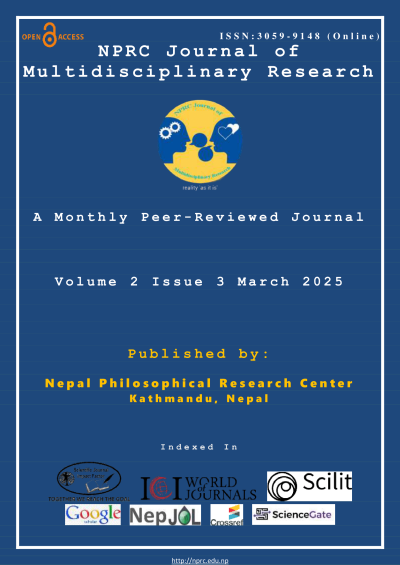Gender Differences in Affinity Toward Technology Among Undergraduate Management Students: A Statistical Analysis
DOI:
https://doi.org/10.3126/nprcjmr.v2i3.76959Keywords:
Artificial Intelligence, Gender Differences, Technology Affinity, Undergraduate Students, Inclusivity, Bootstrap Analysis, Quantitative Research, Technology EducationAbstract
Background: Artificial Intelligence (AI) and emerging technologies are reshaping modern society, with profound implications for education and workforce readiness. Despite the increasing integration of AI across various sectors, higher education has struggled to keep pace, leaving students inadequately prepared for a technology-driven future. Gender disparities in technology engagement and AI knowledge further exacerbate this issue, as societal norms and cultural expectations often influence students' attitudes and comfort levels with technology. Addressing these disparities is essential for fostering inclusivity and ensuring equitable access to technology education. Objective: This study examines gender differences in affinity toward technology among undergraduate students, focusing on their knowledge of AI, attitudes, and comfort levels with technology. The study aims to identify gaps in technology literacy and propose strategies to address gender-based disparities in technology-related education. Methods: A quantitative research approach was employed, utilizing a structured questionnaire administered to 200 undergraduate students from Pokhara University. The questionnaire measured students' affinity for technology using a 7-point Likert scale and assessed their knowledge of AI. Data were analyzed using descriptive statistics, Independent Samples t-tests, and Bootstrap Analysis to compare gender differences and validate the findings. Findings: The results revealed significant gender differences in both AI knowledge and technology affinity. Male students reported higher levels of AI knowledge and greater affinity for technology compared to female students. Female students were overrepresented in lower knowledge categories and reported lower confidence and engagement with technology. These findings were statistically significant, highlighting the need for targeted interventions to address gender disparities. Conclusion: The study emphasizes the importance of addressing gender disparities in technology education to promote inclusivity and equity. Male students demonstrated higher affinity and knowledge, while female students faced barriers such as lower confidence and limited exposure to technology. Educational institutions must implement targeted interventions, adopt inclusive teaching practices, and enhance access to technology resources to bridge these gaps. Novelty: This study contributes to the growing body of research on gender disparities in technology education by providing empirical evidence of differences in AI knowledge and technology affinity among undergraduate students. It also highlights the value of robust statistical methods, such as bootstrapping, to validate findings in gender-related research. The recommendations offered in this study provide actionable strategies for educators and policymakers to promote gender equity in technology-related fields.
Downloads
Downloads
Published
How to Cite
Issue
Section
License
Copyright (c) 2025 The Author(s)

This work is licensed under a Creative Commons Attribution-NonCommercial 4.0 International License.
This license enables reusers to distribute, remix, adapt, and build upon the material in any medium or format for noncommercial purposes only, and only so long as attribution is given to the creator.





